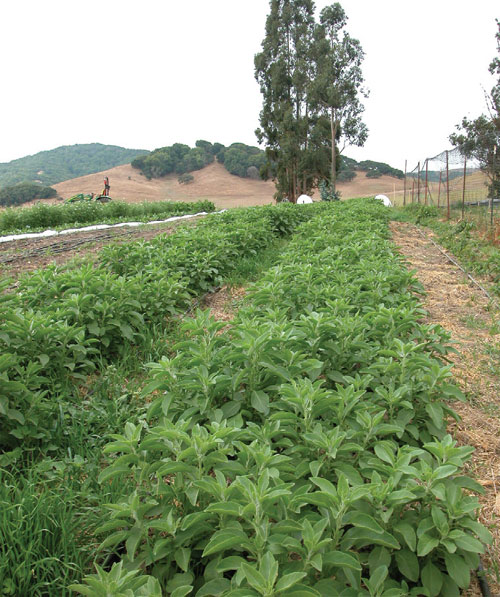US farmers may benefit from wider use of TCM
Updated: 2015-12-31 12:31
By Paul Welitzkin in New York(China Daily USA)
|
|||||||||
Rising American interest in traditional Chinese medicine could open up a new market for US farmers producing the herbs and flowers used by practitioners.
Traditional Chinese medicine (TCM) originated in ancient China and has evolved over thousands of years. TCM practitioners utilize herbal medicines and various mind and body practices, such as acupuncture and tai chi, to treat or prevent health problems, according to the National Institutes of Health.
Western medicine is a disease-based system, while traditional Chinese medicine is based on a model of health or optimum function, noted Jean Giblette, who has been growing Chinese herbs at High Falls Garden in Philmont, New York.
"While Western medicine excels in surgery, emergency medicine, and dentistry, traditional Chinese medicine is more effective for chronic degenerative disease and the maladies that come with aging. I like the word 'complementary' to describe the two systems, each working side by side and doing what they do best," Giblette said in an e-mail.
TCM is slowly gaining acceptance among US medical providers. One of the top hospitals in the US - the Cleveland Clinic - opened a Chinese herbal therapy unit in 2014.
Peg Schafer, who owns and operates the Chinese Medicinal Herb Farm in Petaluma, California, said there are many universities producing high-quality practitioners, particularly in California.
"This is helping to drive up demand that has exceeded the capacity of China," Schafer said in an interview. "Just like in the local food wave now sweeping the country, people want to know the source of their herbal products."
For 18 years, Schafer has been growing items on her 10-acre farm like Salvia miltiorrhiza, a type of sage that "is a beautiful perennial herb with a wide range of functions that have been accepted for use in western medicine", she said.
Her farm also grows Scutellaria baicalensis, a perennial that features purple flowers that can be used to maintain cardiovascular health.
"We are now more of an educational farm," Schafer said. She has two employees and students training to be practitioners "who want to learn more about the medicinal herbs of the trade", she added.
Schafer is convinced that established farmers looking to diversify their product offerings would be successful at commercially producing the plants used in TCM.
"Someone who has successfully germinated plants would be able to transfer those skills to these plants," said Schafer. "This can be done in all climates."
Giblette has started the High Falls Foundation in New York's Hudson Valley to encourage research into the herbs and plants.
"New York has (various) climate zones. Plants hardy enough include Codonopsis pilosula, Sanguisorba officinalis and of course our own Panax quinquefolius or American ginseng," she said.
Schaefer said the startup time for domestic production is about 10 years. Most of the plants take two to five years to get established in polyculture settings, a form of agriculture new to most US farmers.
"The increasingly widespread resistance to antibiotics will be a chance for Chinese herbal medicine to show its power. Pathogens have a harder time developing resistance to a highly complex Chinese herbal formula than to a single drug or herb," Schaefer said.
paulwelitzkin@chinadailyusa.com
|
Peg Schaefer has operated the 10-acre Chinese Medicinal Herb Farm in Petaluma, California, supplying various herbal products for practitioners of traditional Chinese medicine for the last 18 years. Provided to China Daily |
- Top planner targets 40% cut in PM2.5 for Beijing-Tianjin-Hebei cluster
- Yearender: Predictions for 2016 through 20 questions
- Asia's largest underground railway station opens in Shenzhen
- Shanghai bans drug-using actors, drivers
- Clamping down to clean up the air
- Yearender: Ten most talked-about newsmakers in 2015
- Over 1 million refugees have fled to Europe by sea in 2015: UN
- Turbulence injures multiple Air Canada passengers, diverts flight
- NASA releases stunning images of our planet from space station
- US-led air strikes kill IS leaders linked to Paris attacks
- DPRK senior party official Kim Yang Gon killed in car accident
- Former Israeli PM Olmert's jail term cut, cleared of main charge

 Yearender: China's proposals on world's biggest issues
Yearender: China's proposals on world's biggest issues
 NASA reveals entire alphabet but F in satellite images
NASA reveals entire alphabet but F in satellite images
 Yearender: Five major sporting rivalries during 2015
Yearender: Five major sporting rivalries during 2015
 China counts down to the New Year
China counts down to the New Year
 Asia's largest underground railway station opens in Shenzhen
Asia's largest underground railway station opens in Shenzhen
 Yearender: Predictions for 2016 through 20 questions
Yearender: Predictions for 2016 through 20 questions
 World's first high-speed train line circling an island opens in Hainan
World's first high-speed train line circling an island opens in Hainan
 'Internet Plus' changes people's lifestyles in China
'Internet Plus' changes people's lifestyles in China
Most Viewed
Editor's Picks

|

|

|

|

|

|
Today's Top News
Shooting rampage at US social services agency leaves 14 dead
Chinese bargain hunters are changing the retail game
Chinese president arrives in Turkey for G20 summit
Islamic State claims responsibility for Paris attacks
Obama, Netanyahu at White House seek to mend US-Israel ties
China, not Canada, is top US trade partner
Tu first Chinese to win Nobel Prize in Medicine
Huntsman says Sino-US relationship needs common goals
US Weekly

|

|









